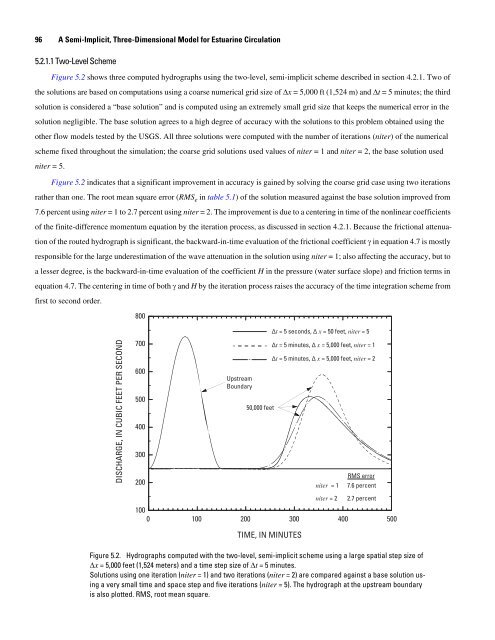A Semi-Implicit, Three-Dimensional Model for Estuarine ... - USGS
A Semi-Implicit, Three-Dimensional Model for Estuarine ... - USGS
A Semi-Implicit, Three-Dimensional Model for Estuarine ... - USGS
Create successful ePaper yourself
Turn your PDF publications into a flip-book with our unique Google optimized e-Paper software.
96 A <strong>Semi</strong>-<strong>Implicit</strong>, <strong>Three</strong>-<strong>Dimensional</strong> <strong>Model</strong> <strong>for</strong> <strong>Estuarine</strong> Circulation<br />
5.2.1.1 Two-Level Scheme<br />
Figure 5.2 shows three computed hydrographs using the two-level, semi-implicit scheme described in section 4.2.1. Two of<br />
the solutions are based on computations using a coarse numerical grid size of Δx = 5,000 ft (1,524 m) and Δt = 5 minutes; the third<br />
solution is considered a “base solution” and is computed using an extremely small grid size that keeps the numerical error in the<br />
solution negligible. The base solution agrees to a high degree of accuracy with the solutions to this problem obtained using the<br />
other flow models tested by the <strong>USGS</strong>. All three solutions were computed with the number of iterations (niter) of the numerical<br />
scheme fixed throughout the simulation; the coarse grid solutions used values of niter = 1 and niter = 2, the base solution used<br />
niter = 5.<br />
Figure 5.2 indicates that a significant improvement in accuracy is gained by solving the coarse grid case using two iterations<br />
rather than one. The root mean square error (RMS e in table 5.1) of the solution measured against the base solution improved from<br />
7.6 percent using niter = 1 to 2.7 percent using niter = 2. The improvement is due to a centering in time of the nonlinear coefficients<br />
of the finite-difference momentum equation by the iteration process, as discussed in section 4.2.1. Because the frictional attenua-<br />
tion of the routed hydrograph is significant, the backward-in-time evaluation of the frictional coefficient γ in equation 4.7 is mostly<br />
responsible <strong>for</strong> the large underestimation of the wave attenuation in the solution using niter = 1; also affecting the accuracy, but to<br />
a lesser degree, is the backward-in-time evaluation of the coefficient H in the pressure (water surface slope) and friction terms in<br />
equation 4.7. The centering in time of both γ and H by the iteration process raises the accuracy of the time integration scheme from<br />
first to second order.<br />
DISCHARGE, IN CUBIC FEET PER SECOND<br />
800<br />
700<br />
600<br />
500<br />
400<br />
300<br />
200<br />
Upstream<br />
Boundary<br />
50,000 feet<br />
100<br />
0 100 200 300 400 500<br />
TIME, IN MINUTES<br />
Δt = 5 seconds, Δ x = 50 feet, niter = 5<br />
Δt = 5 minutes, Δ x = 5,000 feet, niter = 1<br />
Δt = 5 minutes, Δ x = 5,000 feet, niter = 2<br />
RMS error<br />
niter = 1 7.6 percent<br />
niter = 2<br />
2.7 percent<br />
Figure 5.2. Hydrographs computed with the two-level, semi-implicit scheme using a large spatial step size of<br />
Δx = 5,000 feet (1,524 meters) and a time step size of Δt = 5 minutes.<br />
Solutions using one iteration (niter = 1) and two iterations (niter = 2) are compared against a base solution using<br />
a very small time and space step and five iterations (niter = 5). The hydrograph at the upstream boundary<br />
is also plotted. RMS, root mean square.

















